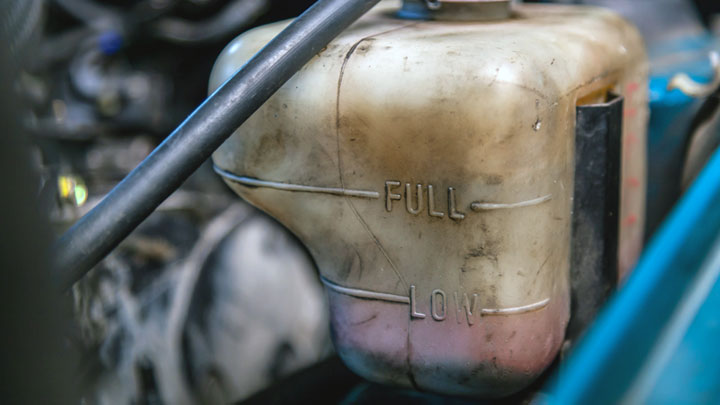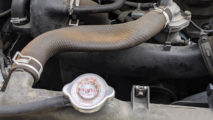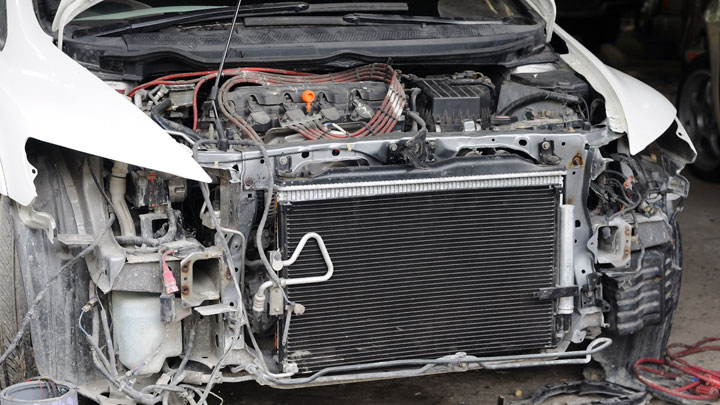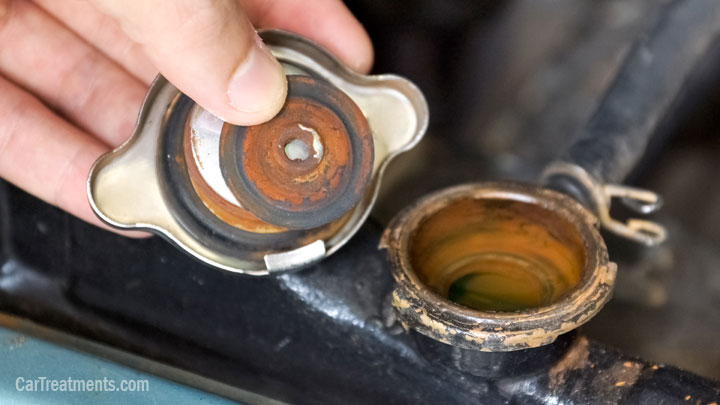Last Updated on October 17, 2022
An internal combustion engine gets very hot as it runs. With so many metal components moving quickly and rubbing together inside of the engine, all that friction creates an enormous amount of heat.
The engine depends on coolant to keep these components cooled down, so they do not overheat. However, the coolant does not just stay cool on its own. The heat from the metal components gets transferred into the coolant. The only way the coolant can get rid of this heat is by circulating through a radiator.
The function of a radiator is to take this heat out of the coolant and place it into the air in which the cooling fan blows in. Then, the coolant liquid circulates back into the engine and cools down the components once again.
As time goes on, the coolant in your cooling system is going to build up with rust, debris, and other small particles. The only way to get rid of this sediment is to perform a coolant flush on the radiator. Otherwise, all those particles will circulate throughout the components of your engine and limit their ability to properly function. Then your engine will be prone to overheating or worse.
See Also: Transmission Fluid Flush vs Change (Which Do You Need?)
How to Perform a Coolant Flush

Below is the general process of cleaning your car radiator by flushing out old coolant. If you notice that you’re losing coolant with no visible leaks, it may also be a good idea to replace your radiator cap as they can go bad over time.
#1 – When to Flush Your Radiator
Car manufacturers may give you different advice on when the right time to flush your radiator is. In general, you’ll want to flush it every 5 years or 100,000 miles, whichever one comes first. Sometimes you might need to perform it sooner, depending on what your driving habits are.
If you ask most auto mechanics, they’ll probably recommend you flush the coolant every 30,000 miles. But in most cases, that short of a flush interval is unnecessary. The best thing to do is dig the vehicle manual out of your glove box and see what the manufacturer recommends.
#2 – Drain Coolant
Obviously, the old coolant needs to be drained from your radiator first. Your engine needs to be cooled down beforehand, so make sure you haven’t driven your car for at least 30 minutes prior to starting this process.
While it’s beneficial for your engine to be warm before changing your oil (since the warmer, thinner oil drains better), no such benefit exists for coolant. You will need to have some time of drain pan placed under the radiator so that it can catch the coolant. Make sure it’s large enough to hold all the coolant (check your owner’s manual for your vehicle’s coolant capacity).
#3 – Add Cleaner
Once the old coolant has been drained from the radiator, you will now add special radiator cleaner to the reservoir of the radiator. You can obtain this cleaning solution at any auto parts store whether local or online. Thermocure and Prestone AS105 are two of the best radiator flushes out there.
After the cleaner is added to the radiator, add distilled water to the reservoir as well. Start the vehicle’s engine and then set your heater to full. For the next 5 minutes, the cleaner and distilled water are going to clean out all the sediment, rust, and other particles from your cooling system. Turn off the engine and let it sit for 30 minutes.
#4 – Drain Again
When the cleaning process is finished, you will need to drain all the cleaning fluid and distilled water from your radiator. This will be a similar process like before where you place a pan underneath the radiator and catch the liquid as it drains from the reservoir.
You may notice the water looking a bit darker than it did when you first added it. That is okay because it is a sign that the radiator flush successfully cleaned the cooling system. Now just flush the cooling system with regular tap water to ensure the sediments are removed and then drain the tap water.
5) Add New Coolant

Finally, you can go ahead and add the new coolant to the radiator reservoir. You will typically mix coolant/antifreeze and distilled water at a 1:1 ratio. So for every 1 gallon of coolant, you’ll want to add 1 gallon of distilled water. Check your owner’s manual just to clarify the exact amounts.
Although you can purchase pre-mixed coolant, you’ll get the most bang for your buck by purchasing the concentrated coolant and distilled water separately. Once you’ve added the correct amount of coolant (again, check your owner’s manual), start your vehicle and let the coolant run through your engine for about 15 minutes.
See Also: Symptoms of a Clogged Radiator
Radiator Flush Cost
The average cost to flush coolant from a radiator is anywhere from $100 to $200. The exact cost will usually depend on where you go (an independent mechanic will be cheaper than a dealership). Some less reputable shops might only charge between $50 and $100.
The amount of coolant your vehicle needs is the other main factor when determining the price of a radiator flush. Usually the engine size will dictate how much coolant you’ll need. It’ll likely be somewhere between 10 to 28 quarts with the average being around 16 quarts (4 gallons). Once again, your owner’s manual will let you know the exact engine coolant capacity.




